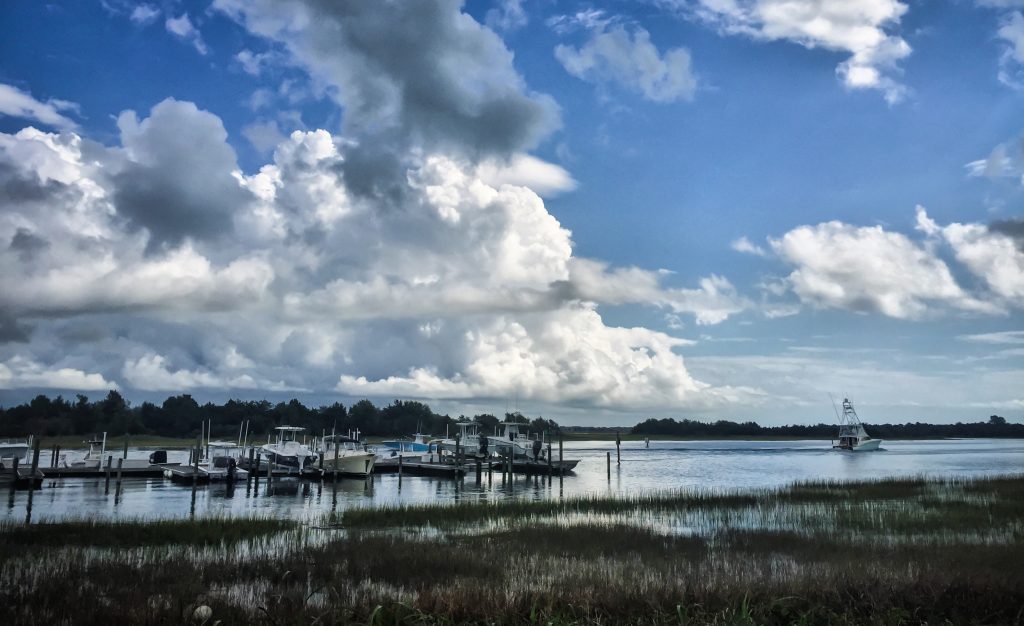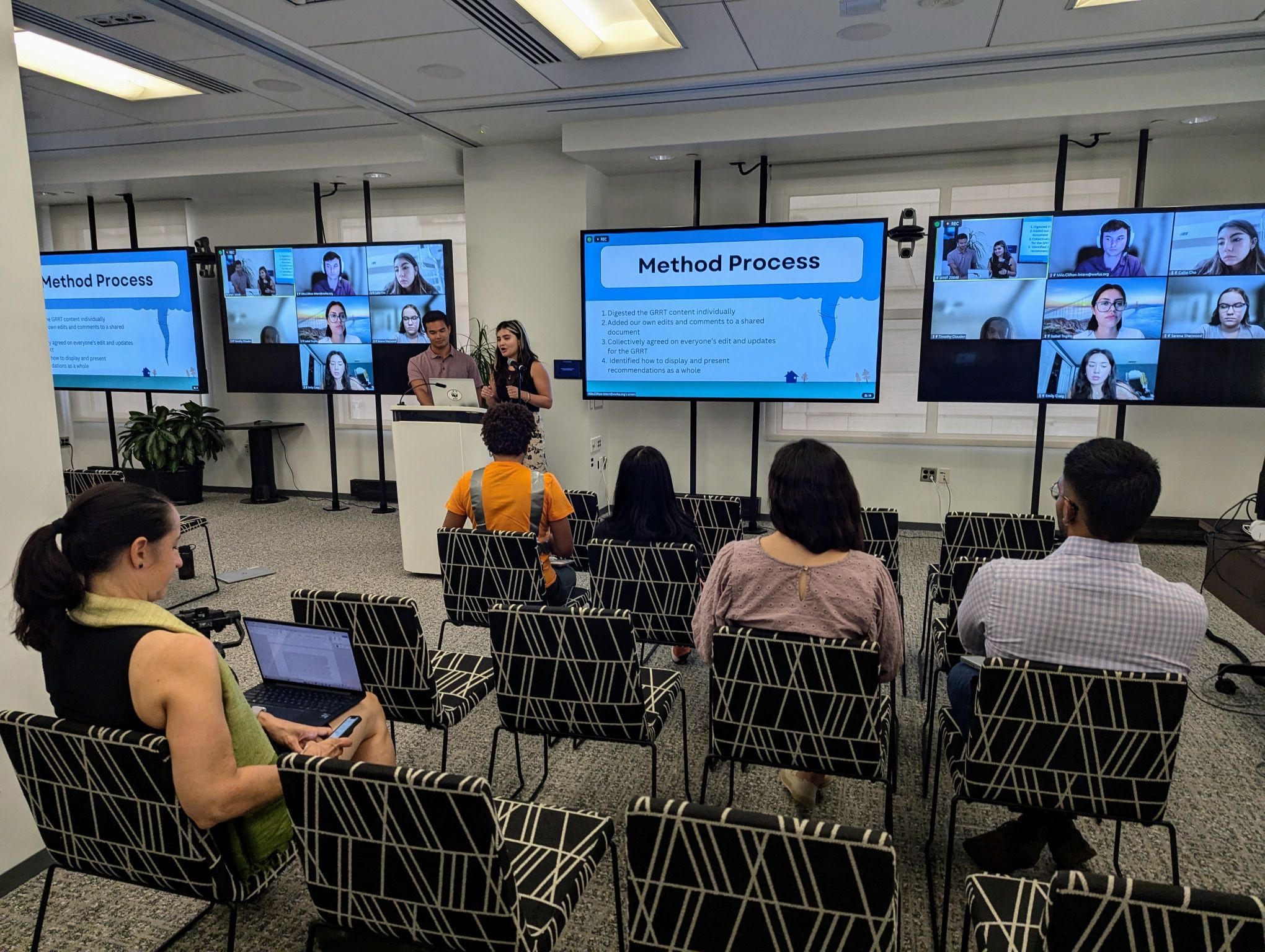Published on:
6 April 2022
Share this:
How a state plan and budget are enabling conditions for the development of nature-based methods.
After frequent, disastrous storms and a state largely in need of repair, Governor Roy Cooper signed Executive Order 801 in October 2018, which is North Carolina’s commitment to address climate change and transition to a clean energy economy. This order created the North Carolina Office of Resilience and Recovery, which focuses on building partnerships to rebuild stronger after disasters.
The order also directed state agencies to collaborate on the Climate Risk Assessment and Resilience Plan2, which comprehensively examines hazards and associated risks across the state. Importantly, the Executive Order prompted recommendations to strengthen policies and programs to make the state less vulnerable to floods while also improving water quality. These institutional policy changes are important to risk reduction and recovery.
North Carolina is a southeastern state located on the US Atlantic Ocean with about 12,331 miles of coastal and estuarine shoreline. The state has suffered its fair share of disastrous hurricanes – Hazel (1954), Hugo (1989), Fran (1996), Matthew (2016), and Florence (2018) to name some of the major ones. These disasters have left regions of the state in disrepair and recovering for years after.
Hurricane Matthew struck the southern portion of North Carolina in 2016 and areas in the coastal plain experienced massive amounts of flooding. In total, the storm resulted in $1.5 billion in damages3. Two years later, Hurricane Florence made landfall but moved further inland through the middle and western portions of the state. Not to be outdone, Florence caused $22 billion in damages4.
One of the outcomes of Executive Order 80 is the Action Plan for Nature-Based Stormwater Strategies, a product from the North Carolina Coastal Federation and the Pew Charitable Trusts5. The North Carolina Coastal Federation is a non-profit organization made up of members and professionals that focuses on protecting and restoring the coast, through education, research, and advocacy. The Action Plan was a collaborative effort that brought together 60 experts across four working groups – New Development, Stormwater Retrofits, Roadways, and Working Lands.
Definitions are important to understand the context in which terms are used, and these can vary according to the context. In the Action Plan, three important terms are 1) low impact development, 2) nature-based solutions, and 3) nature-based stormwater strategies.

Living shorelines often incorporate marsh grasses.
- Low impact development refers to systems and practices that use or mimic natural processes to retain and filter stormwater, but is more specifically an approach to land development or redevelopment that works with nature to manage stormwater as close to its source as possible.
- Nature-based solutions are sustainable planning, design, environmental management, and engineering practices that weave natural features or processes into the built environment to build more resilient communities.
- Nature-based stormwater strategies are methods and practices that work with and enhance the natural capacity of landscapes to store, infiltrate, convey, and treat water.
The Action Plan acknowledged the issues presented by flooding and identified challenges that need to be addressed to make North Carolina more resilient. The four working groups identified numerous impediments, but the major cross-cutting themes were: 1) lack of awareness and education, 2) inflexible planning, regulation, and policy, 3) design challenges, and 4) high cost and/or gaps in funding.
Many state and local land use plans, regulations and policies were developed without nature-based stormwater strategies at the forefront. Some existing rules also constrain the use of nature-based methods by promoting options that are counterproductive to the use of nature-based methods. An example of this is until 2019, private landowners on the coast could apply for a permit to construct a bulkhead for a cost less than a permit for a living shoreline project, and the approval process was much faster. This now-outdated rule promoted hard structures over nature-based methods by expediting permits. Now the process is on equal ground and should promote more living shorelines6.
According to the NC Action Plan for Nature-Based Stormwater Strategies, working groups found cross-cutting impediments and constraints to using these strategies. Most people involved with stormwater management are unfamiliar with nature-based stormwater strategies. There are knowledge gaps amongst a wide diversity of stakeholders, from landowners, developers, and lawmakers, to renters, farmers, and foresters. Most infrastructure projects don’t incorporate nature-based stormwater design early enough and it may only be considered an afterthought.
With new design comes education, retraining, and a shift in mindset about the process of water moving across a landscape. Water doesn’t obey political boundaries, and therefore comprehensive and integrated watershed planning is needed to fully account for downstream impacts. There is also unclear guidance for the responsibility of nature-based stormwater system operation and maintenance.
In response to the many challenges detailed in the Action Plan, four recommendations were posed.
- The first puts the responsibility on the state and local governments to encourage implementing nature-based stormwater strategies wherever and whenever feasible.
- The second is to increase education and professional training about nature-based stormwater and watershed management strategies, such as continuing education and providing opportunities to learn about new ways to manage stormwater.
- The third is to create a steering committee to serve as a leader in nature-based stormwater strategies across the state.
- The last is to establish effective, integrated watershed management that focuses on protecting, restoring, or mimicking natural water systems with goals to reduce flooding and improve water quality.

Nature-based stormwater management strategies like permeable pavement, cisterns and rain gardens promote infiltration and rainwater reuse. These techniques reduce stormwater runoff even on high density development sites.
As of December 2021, several recommendations from the plan are moving forward7. One of the critical first steps identified for organizations and stakeholders within the first year is to form the Action Plan Steering Committee to spearhead efforts to move recommendations forward. This hasn’t been completed yet, but a comprehensive network of potential committee members has been identified as a first step.
The state government of North Carolina successfully passed a full working budget in November 2021, the first since June 2019. Governor Roy Cooper approved and signed the $25.9 billion budget8 and details within the document show funding slated to be allocated to flood resiliency, stormwater projects, and upgraded infrastructure. In relation to nature-based stormwater projects, the following outlines what has been listed:
- $40 million to the Coastal Storm Damage Mitigation fund — part of the North Carolina Department of Environmental Quality, or DEQ — for grants to local governments for coastal storm damage mitigation projects.
- $2 million of this will be allocated to North Carolina Coastal Federation to provide grants for living shorelines, oyster reefs, and marsh restoration to protect other coastal communities that are vulnerable to storm surge and tidal flooding.
- $20 million to DEQ Division of Mitigation Services to be used to develop a statewide Flood Resiliency Blueprint.
- The blueprint will form the backbone of a state flood planning process that increases community resiliency to flooding, shall be a resource for riverine and stream management to reduce flooding, and should support the establishment and furtherance of local government stormwater maintenance programs.
- $1.15 million to DEQ Division of Coastal Management to provide community resilience planning, design, and project implementation grants for the Resilient Coastal Communities Program.
- $300,000 for 2 full time positions to staff the Resilient Coastal Communities Program.
- $15 million to the North Carolina Land and Water Fund — within the Department of Natural and Cultural Resources — to provide grants to counties, municipalities, nonprofits, and state agencies for projects addressing flood risk reduction.
In many communities, a primary source for funding for nature-based stormwater projects is disaster response funds made available after an extreme weather event. As these nature-based projects are implemented and the successes and benefits are demonstrated, flood managers are utilizing federal funding to adopt similar practices. However, it is critical that the state recognize the importance of funding resilience and nature-based projects proactively to reduce disaster risk, instead of reactively in a post-disaster context.
For industries across the state, conventional gray infrastructure projects have been the norm to move water quickly and efficiently away from people. With new tools like this Action Plan and a variety of other resources, one of the main necessities will be embedding these tools in engineering education and continuing education for professionals (engineers, construction workers, etc.), and changing existing policies to support the mainstreaming of natural and nature-based strategies.
State and local governments are the intended users of the Action Plan and as a major infrastructure builder, the state should be a role model in promoting resilient systems wherever possible. The North Carolina Department of Transportation played a major role in contributing to the Action Plan recommendations. As of the writing of this article, they are working to revise a toolbox for stormwater managers to make nature-based methods more prominent and are trying to formalize clear support for projects that are focused on long-term resilience.7
With this Action Plan for Nature-Based Stormwater Strategies, the state expressly recognizes that nature-based methods are key to a more resilient future and that building systems better will improve resiliency. In addition, the plan did well to identify common challenges at the state level and produced strategies for moving forward, setting the stage to be a model for other communities.
Learn more about the North Carolina Action Plan for Nature-Based Stormwater Strategies here.
Footnotes:
- State of North Carolina Executive Order No. 80 – https://governor.nc.gov/media/967/open
- NC Risk Assessment and Resilience Plan – https://deq.nc.gov/energy-climate/climate-change/nc-climate-change-interagency-council/climate-change-clean-energy-plans-and-progress/nc-climate-risk-assessment-and-resilience-plan
- NOAA National Weather Service: Hurricane Matthew in the Carolinas, October 8, 2016 – https://www.weather.gov/ilm/Matthew
- Coastal Review: Florence’s Financial Toll Clearer Two Years On – https://coastalreview.org/2020/09/florences-financial-toll-clearer-two-years-on/
- Pew Charitable Trusts. https://www.pewtrusts.org/en/about
- NC Department of Environmental Quality: Coastal permit now available for marsh sill living shorelines – https://deq.nc.gov/news/press-releases/2019/04/02/coastal-permit-now-available-marsh-sill-living-shorelines
- Todd Miller. Personal communication. November 18, 2021.
- General Assembly of North Carolina Senate Bill 105 – https://webservices.ncleg.gov/ViewBillDocument/2021/53458/0/S105-PCCS25005-MLXR-3



